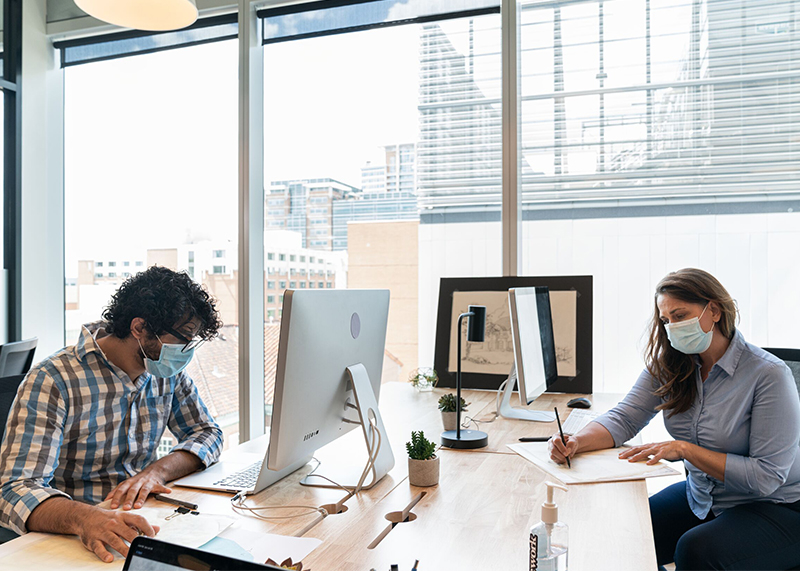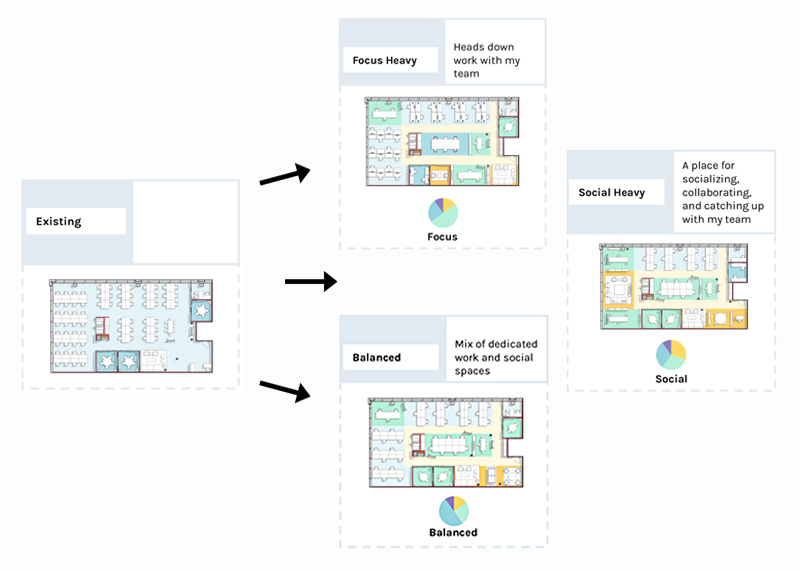Flexibility in the workplace means being able to quickly adapt to new circumstances as they arise. An employee who is flexible can change their plans to navigate or overcome unanticipated obstacles. An employer can encourage this way of thinking by giving employees the freedom to choose how they work—including their own schedules and work locations, things that can be supported by flexible offices.
This is especially important in fast-moving and dynamic industries, where the ability to respond to unpredictable events and changing expectations is a valuable asset for employers and employees alike.
If the events of the past year have taught us anything about how and where we work, it’s that fostering an ability to deal with unexpected situations has benefits in all facets of our lives—the professional and personal. In this article, we’ll look at how to become a more flexible person, the importance of flexibility in teamwork, and some of the advantages of introducing flexibility to your workplace.
Workplace flexibility for employees
How to be flexible in the workplace
What does it mean to be flexible? It can look like an intrinsic personality trait from the outside, but in truth, being flexible is all about preparation and accepting that things will change. While it’s impossible to expect the unexpected, you can still anticipate new developments before they happen and have a plan of action ready to meet the occasion. Some personal developments can be seen coming over the horizon, such as a new baby or a move to a new house. The impact of these events can be thought about long before they happen.
But over a long stretch of time, surprises become inevitable: a project might suddenly fall to pieces after months of hard work, or you might lose your biggest client. But by accepting that unpredictable things will happen, you’ll at least find yourself in the correct mindset to react to them. A sudden change can be stressful, but that stress is exacerbated by the sense that you’ve lost control. By bracing yourself for unanticipated outcomes, you can better retain control over the situation and better position yourself to deal with the fallout.
Benefits of being flexible at work
Flexibility is an important tool in problem-solving. Projects with many moving parts are more manageable when working with flexible team members whose skill sets overlap, and being adaptable to sudden changes means you can react to new conditions without slowing down or becoming stressed. An ability to reshape your role within a team so that you can more easily meet your objectives means you can evolve and grow alongside your company, no matter your job description. Flexibility in business is an asset to most employers, and workers who readily demonstrate their ability to intelligently respond to a changing environment are highly valued.

More importantly, being flexible in the workplace has the added side effect of making you happier in other areas of your life. When you’re less anxious at the office, you’re more able to achieve a healthy work-life balance. An openness to change exposes you to new experiences and new ideas, and could set you off on career paths you hadn’t previously considered.
Skills for becoming flexible at work
Flexibility isn’t wizardry—it’s a skill that can be learned. Practice the skills required to help you become more flexible in the workplace, so that when you encounter an obstacle at work, you’ll have the tools you need to deal with it calmly and effectively. The skills required to achieve flexibility will differ depending on the type of work you do, but here are some general tips to bear in mind.
- Make time in your schedule to stay up to date with the latest trends in your industry. It’s easy to fall into a routine and close yourself off to fresh ideas, especially when you’re a veteran in your field. Pay attention to trends and follow the work of those who are just entering the industry. Study the competition and stay curious about new research and ways of working, especially if these ideas contrast with your way of doing things.
- Practice optimism. When faced with a problem you hadn’t accounted for, it’s natural to focus on the setback rather than the solution. Instead, try to see the potential benefits of a change of plans and aim to respond with positivity. Recognize the impact an unexpected event might have on a task but prioritize the search for an answer to the problem. This is especially important when working in teams, where a defeatist or inflexible attitude can have a disastrous effect on morale.
- Communicate your expectations. Flexibility cuts both ways, and you become way less effective at overcoming problems when you’re not striking a decent work-life balance. If your daily commute is causing anxiety, or maybe you’re finding it difficult to deal with the distractions of working from home, communicate your need for a better solution. This could mean arriving later or working at a dedicated coworking space nearby.
How to demonstrate your flexibility at work
When you’re part of a team that’s willing to help one another out in a tight situation, you’re better equipped to demonstrate flexibility when challenging conditions arise. Create a supportive working environment by offering to assist colleagues when you’ve got the bandwidth to do so. Some examples include taking on some of their tasks, covering a shift, or training them on a system they’re unfamiliar with. This fosters a sense of unity and mutual support within the team, which in turn will encourage your colleagues to help you out when an unanticipated problem lands in your inbox.
During meetings and over email, offer solutions rather than complaints. We have a natural tendency to respond emotionally when circumstances suddenly change for the worse, but this can be destructive. Take a moment to collect your thoughts and then present a few different ideas for overcoming the obstacle. Not voicing your feelings as soon as they arise doesn’t mean your concerns aren’t legitimate, but it’s always best to raise them in a more productive context.
Workplace flexibility for employers
How to know if you have a flexible workplace
A flexible mindset is an attitude that responds well to change. A flexible workplace is an environment that encourages that kind of mindset. The working patterns of flexible employees can fall outside traditional office hours, locations, or job responsibilities. The most basic form of flexible working can be as straightforward as choosing your own start and finish times. But a flexible workplace can also involve novel employment arrangements such as job sharing, remote working, and condensed workweeks.
For employees, the freedom to choose how, where, and when they work has a measurable impact on job satisfaction and productivity. Being able to shape their workday around personal obligations—like dropping the kids off at school or waiting for an important delivery—allows them to strike a healthier work-life balance and to direct their energy toward where it’s needed most.
Benefits of having a flexible workplace
Historically, some bosses have feared that a move away from the usual 9-to-5 would harm business. But studies into flexibility in the workplace show the opposite. When telecom giant Vodafone shifted to an agile working strategy, it saw an increase in productivity and employee engagement. A study by Stanford economist Nicholas Bloom of 16,000 workers found that those who were able to work remotely reported higher job satisfaction and took fewer sick days than their office-based colleagues.
Offering flexibility in the workplace also helps to attract and retain talent. There’s growing demand among younger workers for a less rigid work schedule. Research by Capability Jane found that 92 percent of millennials identify flexibility as their top priority when looking for a job. The same is true at the other end of the workforce, where more than half of over-50s want to ease into their retirement by working flexibly with fewer hours.

Give workers the latitude to approach objectives in their own ways and they will be able to unleash their creativity. Any creative person can tell you that inspiration strikes at the strangest times. Some people do their best work before breakfast, others in the middle of the night. By giving employees the freedom to manage their own schedules rather than compelling them to be at their desk by a certain time, they can more effectively harness their creative energy.
Introducing a flexible working policy can help with overhead too. With fewer employees required to be in the office at any given time, you can cut down on empty office space you no longer need, reducing the cost of your lease.
Ways to increase flexibility in the workplace
There are many ways to incorporate more flexibility into your company culture. It might not be realistic to transition to a totally flexible schedule or to get rid of everyone’s assigned desks, but you can take these small steps toward a less rigid, happier, and more productive workplace.
- Start a discussion about flexible working. Figure out what kind of flexible arrangements your employees actually want and be realistic about what you can offer. Large offices with interdependent departments might not be able to accommodate huge changes in working hours, for example, but they may be able to allow remote working, more paid time off, or a four-day workweek.
- Be clear in your business objectives. A flexible workplace is built around trusting teams to approach objectives in their own way and on their own schedule, so it’s important that goals and deadlines are communicated clearly and understood by all.
- Encourage creativity. Create a supportive environment in which workers are unafraid to share new ideas. A workplace that promotes creativity and lateral thinking is better equipped to navigate complicated problems when they arise.
- Reconfigure the office layout. Flexibility isn’t just an attitude—it extends to the physical layout of the workspace. Provide teams with different areas of the office to work, such as standing desks in quiet corners and common areas where people can come together to collaborate.
How your office space can impact work flexibility
Whether you realize it not, the design of your office space reinforces certain ideas about how your company is run. There are subtle hierarchies in traditional open-plan layouts, from the sightlines of desks to the literal walls between departments. The way we work is changing, but the places we work often still reflect ideas of the past.

A truly flexible workplace requires trust between employers and employees, and the autonomy to choose where and when we do our best work. That means reshaping the physical office to meet these new criteria. A more flexible office leads to a more agile business—one that promotes collaboration and creativity and is better able to navigate the unexpected.
How WeWork can help grow your business’s flexibility
WeWork offices are designed with flexibility in mind. Whether you’re looking for a dedicated workspace for a rotating team, or an office that can quickly scale to fit as many or as few people as required, WeWork provides beautifully designed, adaptable workspaces when and where your company needs it.
For even greater flexibility, WeWork All Access and On Demand let you and your employees access workspaces and meeting rooms in hundreds of locations across multiple cities. This allows everyone to work wherever is most convenient for them, creating ultimate flexibility in the workplace.
Steve Hogarty is a writer and journalist based in London. He is the travel editor of City AM newspaper and the deputy editor of City AM Magazine, where his work focuses on technology, travel, and entertainment.
Rethinking your workspace?








